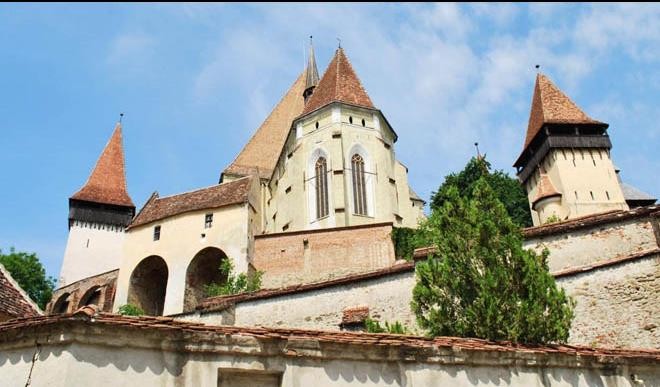Romania’s medieval marital prison
It may sound like a nightmare, but records show that this form of marriage counselling in Transylvania was rather effective. Picturesque Biertan, one of Transylvania’s seven Saxon Unesco World Heritage villages, feels frozen in time. Horse-drawn carts are still a part of daily life, and local residents gather to trade their wares in a cobbled […]


It may sound like a nightmare, but records show that this form of marriage counselling in Transylvania was rather effective.
Picturesque Biertan, one of Transylvania’s seven Saxon Unesco World Heritage villages, feels frozen in time. Horse-drawn carts are still a part of daily life, and local residents gather to trade their wares in a cobbled village square. At the heart of the village, a 15th-Century fortified church towers over the surrounding structures from its hilltop perch.
Inside the church grounds, along one of its fortification walls, is a small building with a room inside barely larger than a pantry. For 300 years, couples whose marriages were on the rocks would find themselves here, locked away for up to six weeks by the local bishop in hope that they would iron out their problems and avert a divorce.
It may sound like a nightmare – but records show that this ‘marital prison’ was rather effective.
In the 300 years there has only been one divorce
“Thanks to this blessed building, in the 300 years that Biertan had the bishop’s seat we only had one divorce,” said Ulf Ziegler, Biertan’s current priest.
Today, the small, dark prison is a museum complete with long-suffering mannequins. The room has low ceilings and thick walls, and is sparsely equipped with a table and chair, a storage chest and a traditional Saxon bed that looks small enough to belong to a child. As couples attempted to repair their marriages inside this tiny space, everything had to be shared, from a single pillow and blanket to the lone table setting.
Lutheranism, the religion of the Transylvanian Saxons, governed most aspects of life, and although divorce was allowed under certain circumstances – such as adultery – it was preferred that couples attempt to save their union. So a couple seeking divorce would voluntarily visit the bishop, who would send them to the marital prison to see if their differences could be reconciled before they parted ways.
“The prison was an instrument to keep society in the old Christian order,” explained Zielger, who noted that it also protected women and children, who were dependent on the family unit to survive. If a divorce did occur, the husband had to pay his ex-wife half of his earnings, but if he remarried and divorced again, the second wife was entitled to nothing.
In the 12th Century, Saxon settlers ‒ originally from areas that today are France, Belgium, Luxembourg and Germany ‒ were invited by Hungary’s King Géza II to settle rural Transylvania and protect it against threats from Tatar and Ottoman invaders, as well as develop the area economically. Transylvanian Saxons were industrious craftspeople; Biertan became an important market town and cultural hub with a 5,000-strong population in 1510.
Walking through the streets of Biertan as the sun begins to disappear behind the rolling hills, a few locals sit outside drinking beers and a farmer moves his hay cart through the village. The imposing church, with its nine surrounding fortification towers, is illuminated by bright lights and its purpose evident: it was a central point for the early Saxon settlers ‒ a place of safety and worship.
The view from the church’s nearly 11m-high fortification walls next to the marital prison extends out across the village and surrounding countryside. Many current residents work their land using old-age farming techniques, and trade their wares to earn a living. Weather-worn shepherds can be spotted in the surrounding green hills herding sheep ‒ a scene that likely hasn’t changed much over the past several centuries.
Life continues to move at a slow, meditative pace; however, these days there is less economic and religious pressure on struggling couples to remain together.
“The reason to remain together was probably not love. The reason was to work and to survive,” Ziegler said. “If a couple was locked inside for six weeks, it was very hard for them to have enough food the following year, so there was pressure to get out and to continue to work together.”
Ziegler believes that, even today, the concept of a marital prison has potential lessons for any modern marriage. And he’s not the only one: he says that he’s received requests from couples looking to use the prison to repair their own struggling marriages.
“In modern families, there is less and less time for each other, we are more selfish than our ancestors,” Ziegler said. “We suffer from loneliness, which is why today we need to talk more, so we can find out what is important to us and what connects us.”
Source: bbc.com
